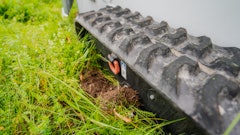
While all engines require standard, routine maintenance as outlined in the owner’s manual, a few additional tips are recommended for edger engines.
A First Glance
Before starting the engine, check the belts to be sure they’re not frayed or cracked. A broken belt will make the edger inoperable, and slow down the entire crew.
Also, check the engine’s recoil rope to be sure it’s fully retracting. Both excess debris and a lack of lubrication can cause the recoil to stick. If it’s hanging loose, remove the recoil return and apply additional lubrication or clean to fix the problem.
Inspect Oil
An engine should never be started without first checking the oil. While most operators have heard this time and time again, many still neglect this simple step. Be sure to wipe off the dipstick before checking the oil to prevent harmful dust or dirt from entering the engine.
Along with checking the oil level and quality each day, be sure to change it frequently. The engine’s oil will likely need to be changed more often than the operator’s manual recommends, as an edger operates in especially dusty, dirty environments.
Air Care
As with any piece of engine-powered equipment, checking the air filter’s condition is an important daily maintenance task. Due to the nature of lawn and landscape applications, a significant amount of debris, including grass and dirt, will be kicked up at the engine during operation. In addition, an edger’s engine is fully exposed to elements, and is located in close proximity to its cutting blade. Keep in mind these added concerns, as they may result in the need to replace the air filter on an edger’s engine a bit more frequently than the owner’s manual recommends.
Clean It Up
A quick cleaning at the end of each day both rids the engine of potentially harmful dirt, and gives the operator a chance to check for anything alarming, including leaks, loose parts and damaged components. Tighten loose parts that are causing leaks or that could vibrate and potentially harm nearby components. Replace anything that is damaged.
Prior to cleaning, always be sure to shut off the engine and allow ample cool-down time. Attempting to clean a hot engine with cold water may cause cracks or other damage, but is also dangerous for the operator. An engine and its components can become extremely hot during operation, and an operator may receive severe burns if a hot part, such as the muffler, is touched.
Though it might seem like the easiest option, never clean an engine with a pressure washer. Instead, use compressed air for clearing away grass, dirt and other light debris. If the engine is especially greasy or dirty, spray it with a non-petroleum-based degreaser, then wipe clean with a cloth or soft brush. Warm water at a low pressure can be used to rinse the engine, just be sure to thoroughly dry the outside, and run the engine for a few minutes to help dry any parts that can’t be reached with a cloth.



















